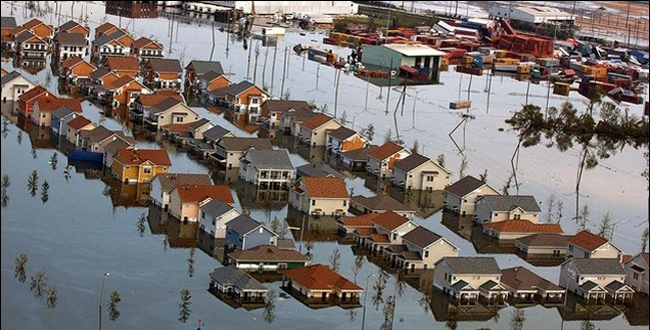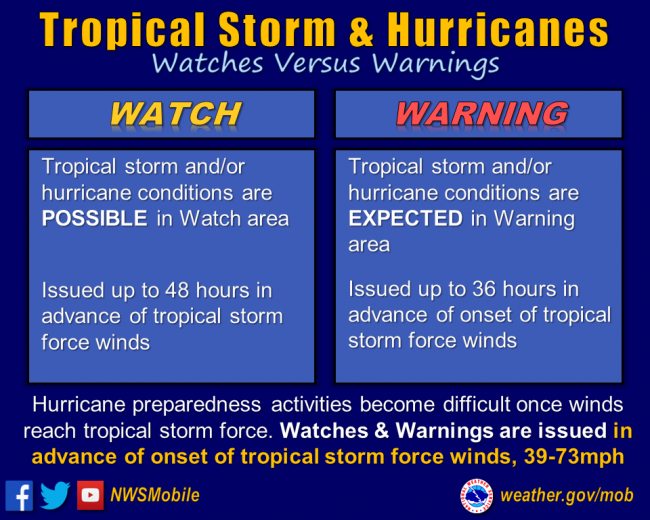
June 1 is the start of the Atlantic hurricane season each year. The season ends on November 30. Although several organizations issue forecasts, no one can predict exactly how many hurricanes we’ll get in a season, or how powerful they’ll be. Here’s a summary, from Wikipedia, of the Atlantic hurricane forecasts issued so far for 2019:
The first forecast for the year was released by the Tropical Storm Risk Consortium (TSR) of University College London on December 11, 2018, which predicted a slightly below-average season in 2019, with a total of 12 named storms, 5 hurricanes, and 2 major hurricanes, due to the anticipated presence of El Niño conditions during the season. On April 4, 2019, Colorado State University released its forecast, predicting a near-average season of 13 named storms, 5 hurricanes and 2 major hurricanes. The next day, TSR released an updated forecast that reiterated its earlier predictions. North Carolina State University released its forecast on April 16, predicting slightly-above average activity with 13–16 named storms, 5–7 hurricanes and 2–3 major hurricanes. On May 6, The Weather Company predicted a slightly-above average season, with 14 named storms, 7 hurricanes, and 3 major hurricanes.
In the Eastern Caribbean and along the U.S. East Coast, the busiest part of hurricane season tends to come between mid-August and mid-September. Now, early in the season, is the time to make a plan to stay safe if a hurricane approaches your area. If you live along the U.S. East Coast or Gulf of Mexico – and don’t have a plan – I hope this post will prepare you. Sit down with your family and figure something out, now.
Bookmark the National Hurricane Center’s current forecast page

Develop an evacuation plan. Do you live in a storm surge hurricane evacuation zone? Would your home be unsafe during a hurricane? The worst damage from hurricanes usually comes from storm surge and flooding. However, stronger hurricanes can produce violent winds that can cause damage to buildings and structures. Also, tropical systems are capable of producing small tornadoes. Develop an evacuation plan. If you were told to evacuate, where would you go, and what routes would you take to get there? Are there a certain procedures your city follows in case of an evacuation? You don’t need to travel hundreds of miles. Identify someone, perhaps a friend or relative who doesn’t live in an evacuation zone or unsafe home, and coordinate with them to use their home as your evacuation destination. While you’re doing this, consider your pets. What will you do with them, if you have to evacuate? Put the plan in writing, and discuss it with your family.
Create a supply kit. According to the National Hurricane Center, your family should have a supply kit. Find a complete list for supply kits here. The kit should include items such as:
- One gallon of water per person daily for up to a week.
- Non-perishable food and medicine to last each person in your family for a minimum of one week. Canned food and juices work really well. Make sure you have a manual can opener and other utensils needed for cooking food.
- Blankets and pillows
- Clothing (including clothing that is water resistant)
- First aid kit, medications, prescription drugs
- Toiletries, hygiene items, moisture wipes, hand sanitizer and soap
- Flashlight and batteries
- A battery-powered radio (consider a NOAA weather radio)
- Cash, because debit and credit cards might not work
- Full tank of gas/extra gasoline
- Pet care items such as food, water, muzzle, leash, and a cage
- A portable crank or solar powered USB charger to charge your cell phone
- Matches or lighter
- If you have babies, make sure you have a decent supply of baby food, diapers, etc.
Consider that, after a hurricane, there could be a long recovery period. Water and electricity could be out for a week or more.
Strengthen your home. Make sure it is in good repair and up to local hurricane building code specifications. Purchase the supplies (plywood, steel or aluminum panels) to board up windows and doors to protect your home. Get the supplies now instead of two to three days before a storm hits. Your garage door is the most vulnerable part of a home, so be sure it can withstand high winds. Figure out what needs to be taken inside in case floods or strong winds pick up any of your belongings. Visit FEMA’s mitigation page.
Consider your insurance needs. This Hurricane Preparedness Week, call your insurance company or agent and ask for an insurance checkup to make sure you have enough homeowners insurance to repair or even replace your home. Standard homeowners insurance doesn’t cover flooding. Here’s a page about flood insurance from FEMA. Whether you’re a homeowner or renter, you’ll need a separate policy for flooding. Act now as flood insurance requires a 30-day waiting period.
Think about, and talk with, your neighbors. Now, before a hurricane is approaching, hold a neighborhood meeting to discuss ways neighbors can help each other. How does your community at large prepare for a hurricane? Consider those with special needs in the neighborhood, such as seniors. More tips for neighborhoods, here.

If a hurricane is imminent … First, understand the difference between watches and warnings. Hurricane watches mean hurricane conditions (74 mile per hour [119 kph] winds or greater) are possible within 48 hours. Hurricane warnings mean hurricane conditions are expected. If a hurricane is imminent …
Turn down your freezer and refrigerator to the coldest settings possible. If you lose electricity, your perishable foods will last longer.
Turn off propane tanks and small electrical appliances.
Consider whether you really want to stay at your house.
Pay careful attention to hurricane forecasts. Mother Nature can be highly unpredictable. A forecast Category One hurricane could end up being a strong Category Two, or higher, causing more damage than predicted.
More information from the Red Cross about being prepared for a hurricane
Hurricane preparedness and safety from the National Hurricane Center

Bottom line: June 1 is the start of the 2018 hurricane season. Are you prepared for a hurricane if one approaches your area? If you live along the Gulf of Mexico or East Coast and don’t have a plan, this post can help you prepare.
Hurricane Survival Tips: How to Stay Safe During a Hurricane
9 Affordable Ways to Prep Your Home for Hurricane Season
Disaster Preparedness for Pets
Enjoying EarthSky? Sign up for our free daily newsletter today!











